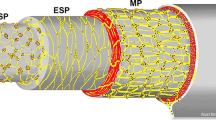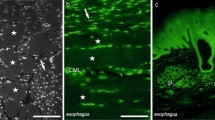Abstract
Equine ileocolonic aganglionosis, which is also called lethal white foal syndrome (LWFS), is a severe congenital condition characterized by the unsuccessful colonization of neural crest progenitors in the caudal part of the small intestine and the entire large intestine. LWFS, which is attributable to a mutation in the endothelin receptor B gene, is the horse equivalent of Hirschsprung’s disease in humans. Affected foals suffer from aganglionosis or hypoganglionosis of the enteric ganglia resulting in intestinal akinesia and colic. In other species with aganglionosis, fibers of extrinsic origin show an abnormal distribution pattern within the gut wall, but we have no information to date regarding this occurrence in horses. Our present aim is to investigate the distribution of extrinsic sympathetic and sensory neural fibers in LWFS, focusing on ileum and the pelvic flexure of the colon of two LWFS foals compared with a control subject. The sympathetic fibers were immunohistochemically identified with the markers tyrosine hydroxylase and dopamine beta-hydroxylase. The extrinsic sensory fibers were identified with the markers Substance P (SP) and calcitonin gene-related peptide (CGRP). Since SP and CGRP are also synthesized by subclasses of horse intramural neurons, LWFS represents a good model for the selective study of extrinsic fiber distribution. Affected foals showed large bundles of extrinsic fibers, compared with the control, as observed in Hirschsprung’s disease. Furthermore, altered adrenergic pathways were observed, prominently in the pelvic flexure. The numbers of SP- and CGRP-immunoreactive fibers in the muscle, a target of enteric neurons, were dramatically reduced, whereas fibers deduced to be extrinsic sensory axons persisted around submucosal blood vessels. Fiber numbers in the mucosa were reduced. Thus, extrinsic innervation, contributing to modulate enteric functions, might also be affected during LWFS.



Similar content being viewed by others
References
Baynash AG, Hosoda K, Giaid A, Richardson JA, Emoto N, Hammer RE, Yanagisawa M (1994) Interaction of endothelin-3 with endothelin-B receptor is essential for development of epidermal melanocytes and enteric neurons. Cell 79:1277–1285
Boesmans W, Lasrado R, Vanden Berghe P, Pachnis V (2015) Heterogeneity and phenotypic plasticity of glial cells in the mammalian enteric nervous system. Glia 63:229–241
Bombardi C, Grandis A, Gardini A, Sorteni C, Clavenzani P, Chiocchetti R (2013) Expression of beta2 adrenoceptors within enteric neurons of the horse ileum. Res Vet Sci 95:837–845
Brain SD, Williams TJ (1985) Inflammatory oedema induced by synergism between calcitonin gene-related peptide (CGRP) and mediators of increased vascular permeability. Br J Pharmacol 86:855–860
Brain SD, Williams TJ (1988) Substance P regulates the vasodilator activity of calcitonin gene-related peptide. Nature 335:73–75
Carnahan JF, Anderson DJ, Patterson PH (1991) Evidence that enteric neurons may derive from the sympathoadrenal lineage. Dev Biol 148:552–561
Ceccherini I, Zhang AL, Matera I, Yang G, Devoto M, Romeo G, Cass DT (1995) Interstitial deletion of the endothelin-B receptor gene in the spotting lethal (sl) rat. Hum Mol Genet 4:2089–2096
Chiocchetti R, Grandis A, Bombardi C, Lucchi ML, Dal Lago DT, Bortolami R, Furness JB (2006) Extrinsic and intrinsic sources of calcitonin gene-related peptide immunoreactivity in the lamb ileum: a morphometric and neurochemical investigation. Cell Tissue Res 323:183–196
Chiocchetti R, Bombardi C, Mongardi Fantaguzzi C, Russo D, Venturelli E, Montoneri C, Spadari A, Romagnoli N, Grandis A (2009a) Intrinsic innervation of the ileocaecal junction in the horse: preliminary study. Equine Vet J 41:759–764
Chiocchetti R, Bombardi C, Mongardi-Fantaguzzi C, Venturelli E, Russo D, Spadari A, Montoneri C, Romagnoli N, Grandis A (2009b) Intrinsic innervation of the horse ileum. Res Vet Sci 87:177–185
Chiocchetti R, Giancola F, Mazzoni M, Sorteni C, Romagnoli N, Pietra M (2015) Excitatory and inhibitory enteric innervation of horse lower esophageal sphincter. Histochem Cell Biol 143:625–635
Daniel EE, Furness JB, Costa M, Belbeck L (1987) The projections of chemically identified nerve fibres in canine ileum. Cell Tissue Res 247:377–384
Ding X, Zhao Z, Duan W, Wang S, Jin X, Xiang L (2013) Expression patterns of CXCR4 in different colon tissue segments of patients with Hirschsprung’s disease. Exp Mol Pathol 95:111–116
Facer P, Knowles CH, Tam PK, Ford AP, Dyer N, Baecker PA, Anand P (2001) Novel capsaicin (VR1) and purinergic (P2X3) receptors in Hirschsprung’s intestine. J Pediatr Surg 36:1679–1684
Finno CJ, Spier SJ, Valberg SJ (2009) Equine diseases caused by known genetic mutations. Vet J 179:336–347
Freytag C, Seeger J, Siegemund T, Grosche J, Grosche A, Freeman DE, Schusser GF, Hartig W (2008) Immunohistochemical characterization and quantitative analysis of neurons in the myenteric plexus of the equine intestine. Brain Res 1244:53–64
Gershon MD (2012) NPARM in PHOX2B: why some things just should not be expanded. J Clin Invest 122:3056–3058
Hanesch U, Schaible HG (1995) Effects of ankle joint inflammation on the proportion of calcitonin gene-related peptide (CGRP)-immunopositive perikarya in dorsal root ganglia. Prog Brain Res 104:339–347
Hartig W, Reichenbach A, Voigt C, Boltze J, Bulavina L, Schuhmann MU, Seeger J, Schusser GF, Freytag C, Grosche J (2009) Triple fluorescence labelling of neuronal, glial and vascular markers revealing pathological alterations in various animal models. J Chem Neuroanat 37:128–138
Heanue TA, Pachnis V (2006) Expression profiling the developing mammalian enteric nervous system identifies marker and candidate Hirschsprung disease genes. Proc Natl Acad Sci U S A 103:6919–6924
Hudson NP, Pearson GT, Mayhew IG (2000) Tissue culture of the enteric nervous system from equine ileum. Vet Res Commun 24:299–307
Hultgren BD (1982) Ileocolonic aganglionosis in white progeny of Overo spotted horses. J Am Vet Med Assoc 180:289–292
Julian AF (1994) Ileocolonic aganglionosis in an Overo foal. N Z Vet J 42:75–76
Kapur RP (2009) Practical pathology and genetics of Hirschsprung’s disease. Semin Pediatr Surg 18:212–223
Kato H, Yamamoto T, Yamamoto H, Ohi R, So N, Iwasaki Y (1990) Immunocytochemical characterization of supporting cells in the enteric nervous system in Hirschsprung’s disease. J Pediatr Surg 25:514–519
Knowles CH, De Giorgio R, Kapur RP, Bruder E, Farrugia G, Geboes K, Gershon MD, Hutson J, Lindberg G, Martin JE, Meier-Ruge WA, Milla PJ, Smith VV, Vandervinden JM, Veress B, Wedel T (2009) Gastrointestinal neuromuscular pathology: guidelines for histological techniques and reporting on behalf of the Gastro 2009 International Working Group. Acta Neuropathol 118:271–301
Lefebvre D, Hudson NP, Elce YA, Blikslager A, Divers TJ, Handel IG, Tremaine WH, Pirie RS (2015) Clinical features and management of equine postoperative ileus (POI): Survey of Diplomates of the American Colleges of Veterinary Internal Medicine (ACVIM), Veterinary Surgeons (ACVS) and Veterinary Emergency and Critical Care (ACVECC). Equine Vet J. doi:10.1111/evj.12520
Lightbody T (2002) Foal with Overo lethal white syndrome born to a registered quarter horse mare. Can Vet J 43:715–717
Liu JA, Lai FP, Gui HS, Sham MH, Tam PK, Garcia-Barcelo MM, Hui CC, Ngan ES (2015) Identification of GLI mutations in patients with Hirschsprung disease that disrupt enteric nervous system development in mice. Gastroenterology 149:1837-1848. doi:10.1053/j.gastro.2015.07.060
Luhken G, Fleck K, Pauciullo A, Huisinga M, Erhardt G (2012) Familiar hypopigmentation syndrome in sheep associated with homozygous deletion of the entire endothelin type-B receptor gene. PLoS One 7:e53020
Matsumoto K, Hosoya T, Tashima K, Namiki T, Murayama T, Horie S (2011) Distribution of transient receptor potential vanilloid 1 channel-expressing nerve fibers in mouse rectal and colonic enteric nervous system: relationship to peptidergic and nitrergic neurons. Neuroscience 172:518–534
McCabe L, Griffin LD, Kinzer A, Chandler M, Beckwith JB, McCabe ER (1990) Overo lethal white foal syndrome: equine model of aganglionic megacolon (Hirschsprung disease). Am J Med Genet 36:336–340
McCallion AS, Chakravarti A (2001) EDNRB/EDN3 and Hirschsprung disease type II. Pigment Cell Res 14:161–169
Metallinos DL, Bowling AT, Rine J (1998) A missense mutation in the endothelin-B receptor gene is associated with lethal white foal syndrome: an equine version of Hirschsprung disease. Mamm Genome 9:426–431
Moore SW (2015) Total colonic aganglionosis and Hirschsprung’s disease: a review. Pediatr Surg Int 31:1–9
Muniz E, Lobo Ladd AA, Lobo Ladd FV, Silva AA da, Kmit FV, Borges AS, Teixeira R, Mota LS da, Belli CB, Zoppa AL de, Silva LC da, Melo MP de, Coppi AA (2013) 3-D technology used to accurately understand equine ileocolonic aganglionosis. Cells Tissues Organs 198:160–168
Nagashimada M, Ohta H, Li C, Nakao K, Uesaka T, Brunet JF, Amiel J, Trochet D, Wakayama T, Enomoto H (2012) Autonomic neurocristopathy-associated mutations in PHOX2B dysregulate Sox10 expression. J Clin Invest 122:3145–3158
Pavone S, Mandara MT (2010) A morphological and quantitative immunohistochemical study of the interstitial cells of Cajal in the normal equine intestinal tracts. Equine Vet J 42:358–366
Rabah R (2010) Total colonic aganglionosis: case report, practical diagnostic approach and pitfalls. Arch Pathol Lab Med 134:1467–1473
Reissmann M, Ludwig A (2013) Pleiotropic effects of coat colour-associated mutations in humans, mice and other mammals. Semin Cell Dev Biol 24:576–586
Robertson K, Mason I, Hall S (1997) Hirschsprung’s disease: genetic mutations in mice and men. Gut 41:436–441
Ruhl A (2005) Glial cells in the gut. Neurogastroenterol Motil 17:777–790
Russo D, Bombardi C, Grandis A, Furness JB, Spadari A, Bernardini C, Chiocchetti R (2010) Sympathetic innervation of the ileocecal junction in horses. J Comp Neurol 518:4046–4066
Russo D, Bombardi C, Castellani G, Chiocchetti R (2011) Characterization of spinal ganglion neurons in horse (Equus caballus). A morphometric, neurochemical and tracing study. Neuroscience 176:53–71
Russo D, Castellani G, Chiocchetti R (2012) Expression of high-molecular-mass neurofilament protein in horse (Equus caballus) spinal ganglion neurons. Microsc Res Tech 75:626–637
Santschi EM, Purdy AK, Valberg SJ, Vrotsos PD, Kaese H, Mickelson JR (1998) Endothelin receptor B polymorphism associated with lethal white foal syndrome in horses. Mamm Genome 9:306–309
Santschi EM, Vrotsos PD, Purdy AK, Mickelson JR (2001) Incidence of the endothelin receptor B mutation that causes lethal white foal syndrome in white-patterned horses. Am J Vet Res 62:97–103
Tomuschat C, Puri P (2015) RET gene is a major risk factor for Hirschsprung’s disease: a meta-analysis. Pediatr Surg Int 31:701–710
Uesaka T, Nagashimada M, Enomoto H (2015) Neuronal differentiation in Schwann cell lineage underlies postnatal neurogenesis in the enteric nervous system. J Neurosci 35:9879–9888
Vonderfecht SL, Bowling AT, Cohen M (1983) Congenital intestinal aganglionosis in white foals. Vet Pathol 20:65–70
Vrotsos PD, Santschi EM, Purdy AK, Mickelson JR (1999) Incidence of an endothelin receptor B mutation in white patterned horses; evidence for genetic heterogeneity in the Overo coat pattern. Plant & Animal Genomes VII Conference Proceedings, Plant & Animal Genomes VII Conference, San Diego, California, January 18-22, 1999
Walter GC, Phillips RJ, Mcadams JL, Powley TL (2016) Individual sympathetic postganglionic neurons co-innervate myenteric ganglia and smooth muscle layers in the gastrointestinal tract of the rat. J Comp Neurol. doi:10.1002/cne.23978
Watanabe Y, Ito T, Harada T, Kobayashi S, Ozaki T, Nimura Y (1995) Spatial distribution and pattern of extrinsic nerve strands in the aganglionic segment of congenital aganglionosis: stereoscopic analysis in spotting lethal rats. J Pediatr Surg 30:1471–1476
Watanabe Y, Ito F, Ando H, Seo T, Harada T, Kaneko K, Ishiguro Y, Kobayashi S (1998) Extrinsic nerve strands in the aganglionic segment of Hirschsprung’s disease. J Pediatr Surg 33:1233–1237
Yang GC, Croaker D, Zhang AL, Manglick P, Cartmill T, Cass D (1998) A dinucleotide mutation in the endothelin-B receptor gene is associated with lethal white foal syndrome (LWFS); a horse variant of Hirschsprung disease. Hum Mol Genet 7:1047–1052
Zuelzer WW, Wilson JL (1948) Functional intestinal obstruction on a congenital neurogenic basis in infancy. Am J Dis Child 75:40–64
Acknowledgements
The excellent technical assistance of Dr. Riccardo Rinnovati is gratefully acknowledged.
Author information
Authors and Affiliations
Corresponding author
Ethics declarations
Funding
This research was supported by no specific grant from any funding agency in the public, commercial, or not-for-profit sector.
Conflict of interest
The authors declare that they have no conflict of interest.
Electronic supplementary material
Below is the link to the electronic supplementary material.
ESM 1
(PDF 776 kb)
Rights and permissions
About this article
Cite this article
Giancola, F., Gentilini, F., Romagnoli, N. et al. Extrinsic innervation of ileum and pelvic flexure of foals with ileocolonic aganglionosis. Cell Tissue Res 366, 13–22 (2016). https://doi.org/10.1007/s00441-016-2422-x
Received:
Accepted:
Published:
Issue Date:
DOI: https://doi.org/10.1007/s00441-016-2422-x




